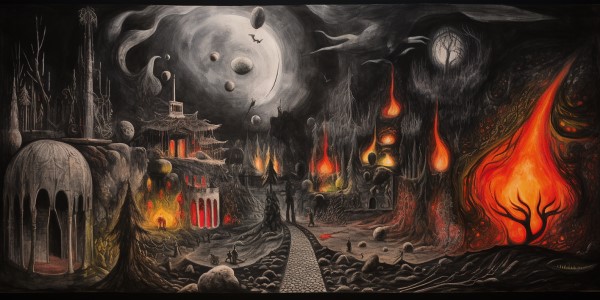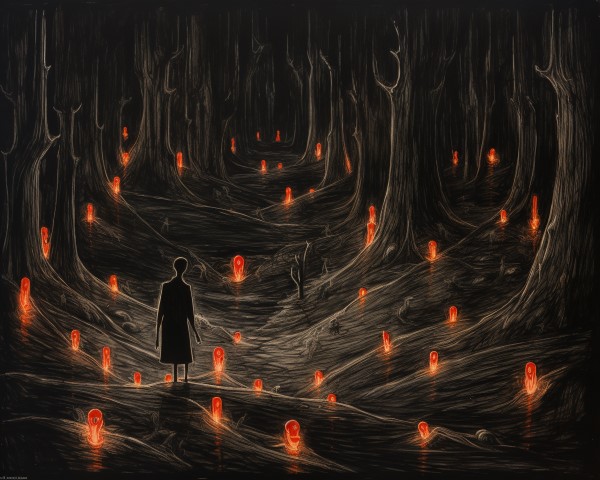KidZone Geography: Greek Mythology
About Hades, Ruler of the Underworld
Introduction to Hades
Hades, one of the twelve Olympian deities in Greek mythology, is the god of the underworld. Known for his stern and unyielding nature, Hades rules over the realm of the dead and ensures the balance between life and death. Often depicted with his bident (two-pronged staff) and accompanied by his three-headed dog, Cerberus, Hades is a formidable figure in Greek mythology.

Quick Facts About Hades
What is Hades the Greek god of?
Hades is the Greek god of the underworld and the dead. He governs the realm where souls reside after death and oversees the process of judging and rewarding or punishing the souls of the deceased.

The Underworld: Greek Mythology's Realm of Souls
What are Hades's sacred animals?
Hades's sacred animals include Cerberus, his three-headed dog that guards the entrance to the underworld, and the screech owl, symbolizing death and the afterlife.
What are Hades's symbols?
Hades's primary symbols are the bident, the Helm of Darkness (also known as the Cap of Invisibility), and the pomegranate. The bident represents his authority, the Helm of Darkness grants him invisibility, and the pomegranate is associated with his wife, Persephone, and the cycle of life and death.
Origins and Birth
The Titanomachy
Hades was born to the Titans Cronus and Rhea, making him a sibling to Zeus, Poseidon, Hera, Demeter, and Hestia. Like his brothers and sisters, Hades was swallowed at birth by Cronus, who feared a prophecy that one of his children would overthrow him. Rescued by Zeus, Hades joined his siblings in the Titanomachy, a war against the Titans. After their victory, the three brothers drew lots to divide the cosmos, with Hades becoming the ruler of the underworld.
The Rise of Hades
Hades's dominion over the underworld was established after the Titanomachy. Though he resides in the realm of the dead, Hades is a powerful and respected god among the Olympians. His role is crucial in maintaining the balance between life and death, and his judgment ensures that souls receive their rightful fate.
Hades's Role in Greek Mythology

Ruler of the Underworld
Hades's primary role is as the ruler of the underworld, where he governs the souls of the deceased. He ensures the proper administration of justice, rewarding the virtuous and punishing the wicked. His domain includes various regions such as the Elysian Fields, a paradise for the blessed, and Tartarus, a place of torment for the damned.
God of Wealth
Hades is also known as the god of wealth, often referred to as "Plouton" or "Pluto." This association stems from the riches found underground, such as precious metals and fertile soil. His connection to wealth highlights the duality of his character, both as a grim ruler and a provider of life's essentials.

Iconography and Symbols
The Bident
The bident, a two-pronged staff, is Hades's most recognizable symbol. It signifies his authority and power over the underworld. Similar to Poseidon's trident, the bident is a potent symbol of Hades's control.
The Helm of Darkness
The Helm of Darkness, also known as the Cap of Invisibility, is another significant symbol. This magical artifact allows Hades to become invisible, a useful tool for moving unseen among both gods and mortals. It was famously used by Perseus during his quest to behead Medusa.
The Pomegranate
The pomegranate is closely associated with Hades due to the myth of Persephone. When Hades abducted Persephone to be his queen, she ate pomegranate seeds, binding her to the underworld for part of each year. This fruit symbolizes the cycle of life and death, as well as the changing seasons.
Major Myths Involving Hades
The Abduction of Persephone
The Story of Hades and Persephone
One of the most well-known myths involving Hades is the abduction of Persephone. Hades fell in love with Persephone, the daughter of Demeter, and kidnapped her to be his queen. Demeter's grief caused the earth to become barren, leading to the creation of the seasons. Eventually, a compromise was reached: Persephone would spend part of the year with Hades in the underworld and the rest with Demeter on earth, symbolizing the cycle of growth and harvest.
The Punishment of Sisyphus
Hades also plays a key role in the myth of Sisyphus, a king punished for his deceitfulness and hubris. Sisyphus was condemned to an eternal punishment of rolling a boulder up a hill, only for it to roll back down each time he reached the top. This myth highlights Hades's role in enforcing justice and punishing wrongdoers.
The Judgment of the Dead
Hades is involved in the judgment of souls entering the underworld. The dead are judged by three judges: Minos, Rhadamanthus, and Aeacus. They decide whether a soul goes to the Elysian Fields, Tartarus, or the Asphodel Meadows, based on their deeds in life. Hades oversees this process, ensuring that each soul receives its due.
Hades's Relationships and Offspring

Marriage to Persephone
Hades's primary relationship is with Persephone, the goddess of spring and queen of the underworld. Their union, though initially born out of abduction, represents a complex and balanced partnership. Persephone's presence in the underworld brings a touch of life and renewal to Hades's realm.
Other Relationships
Hades had fewer relationships compared to his brothers Zeus and Poseidon. However, he fathered several children, including:
- Zagreus: A god associated with rebirth and the underworld, often identified with Dionysus in Orphic mythology.
- Macaria: The goddess of the blessed death.
Worship and Cult of Hades

Temples and Sanctuaries
Hades's worship was more subdued compared to other Olympian gods, partly due to the fear and reverence associated with him. He had few temples, but significant sites included:
- The Necromanteion of Ephyra: An ancient temple in Epirus where rituals to communicate with the dead were performed.
- The Sanctuary of Pluto: Near Eleusis, connected to the Eleusinian Mysteries and the worship of Demeter and Persephone.
Festivals and Rituals
Worship of Hades often involved chthonic rituals, which were performed at night or in underground locations. Sacrifices were made in pits or trenches, with black animals such as sheep or bulls being common offerings. These rituals emphasized Hades's connection to the earth and the afterlife.
Hades in Art and Literature

Classical Depictions
In classical art, Hades is often depicted as a stern, bearded man holding a bident or seated on a throne. He is sometimes shown with Cerberus, the three-headed dog, or accompanied by Persephone. These depictions emphasize his role as the ruler of the underworld and the enforcer of justice.
Renaissance and Beyond
During the Renaissance, artists like Michelangelo and Bernini drew inspiration from classical depictions of Hades, incorporating him into their works. Michelangelo's depiction of Hades in the Sistine Chapel is a notable example, blending classical themes with Christian symbolism.
Modern Interpretations
In modern times, Hades continues to be a prominent figure in literature, film, and popular culture. He appears in various forms, from comic books and movies to television series and video games. These contemporary portrayals often explore different aspects of his character, from his stern authority to his complex relationship with Persephone. In the Percy Jackson series, for example, Hades is depicted as a misunderstood and often antagonistic figure, reflecting modern interpretations of his myth.
Conclusion
Hades remains one of the most compelling figures in Greek mythology. His role as the god of the underworld and the dead, combined with his complex personality and significant myths, make him a fascinating character. As the ruler of the underworld, Hades ensures the balance between life and death, maintaining the order of the cosmos. His enduring influence can be seen in the continued fascination with his myths and the artistic representations that keep his legend alive. Through his worship, iconography, and the rich tapestry of stories that surround him, Hades exemplifies the complexities and grandeur of ancient Greek religion and mythology.

